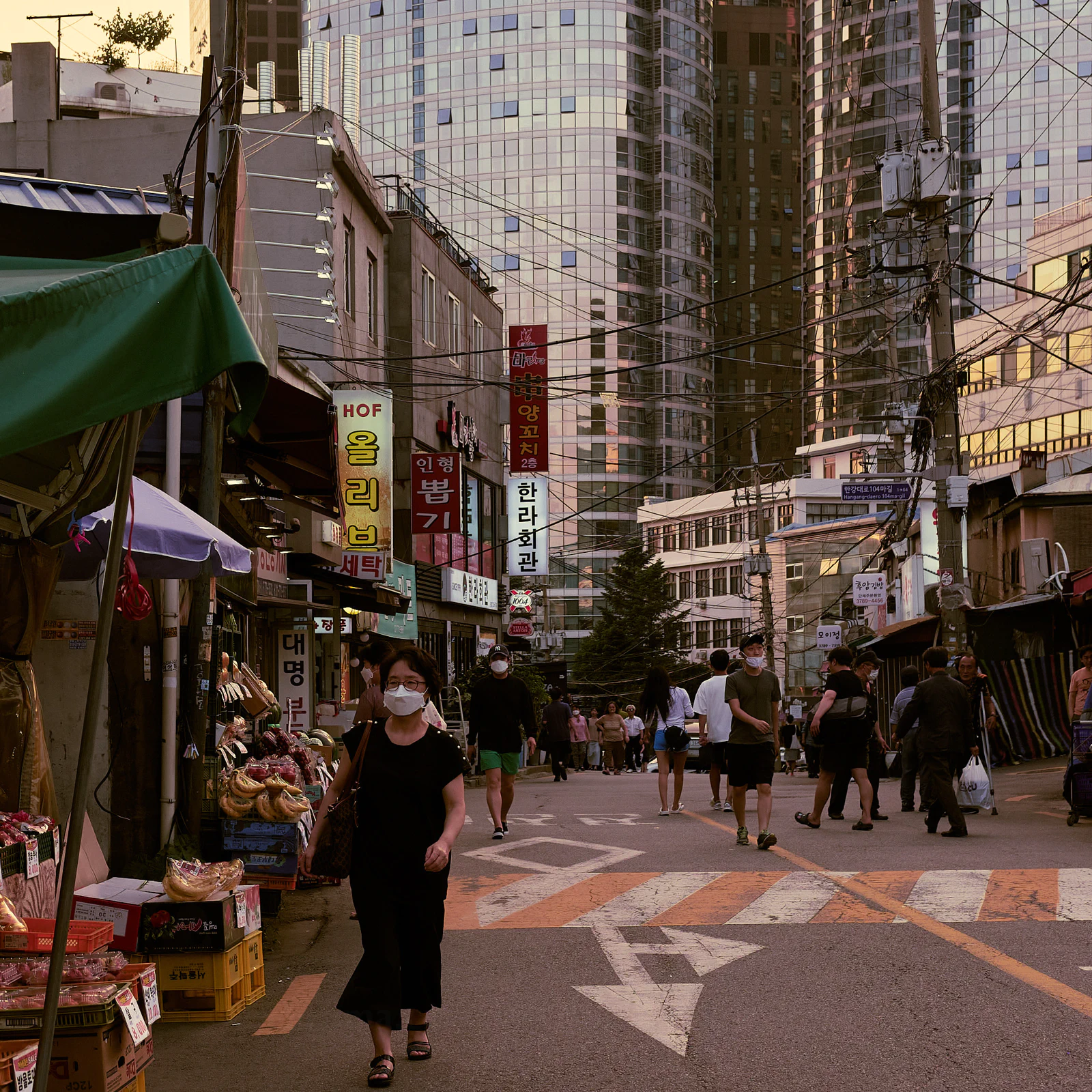Huam-dong, a mix of old and new
Just a few hundred metres down from Seoul station (서울역) there is this small, rather old neighbourhood called Huam-dong (후암동). Layering Seoul’s modern cityscape with the gritty old, it is still home to older buildings and the Huam Traditional Market (후암시장). Huam-dong is neighbourhood where different pieces of history still remain visible, yet it still is lively today.
While standing in front of the entrance to the Huam Traditional Market, these towering glass giants divide the old town from Seoul station.

Seoul Station — feeding a major transport artery in Korea.
The central location of Seoul Station makes it into a beating heart of the city. It’s a major railway hub – its train tracks easily distinguishable from above in satelite photos – housing several Korail and Seoul Subway services, as well as being the final stop on the AREX line, which connects Incheon and Gimpo airport with Seoul by rail. This means it is frequently visited for both commuter and long-distance traffic, connecting passengers with Subway lines 1 and 4, or KTX express trains towards Busan, Gangneung, Jinju and Mokpo. It accomodates many restaurants, and plentiful shopping opportunities: just next door there is a full-fledged Lotte Mall.
Architecturally, it sits nicely with the glass built highrises in its vicinity. However, interestingly enough, the bright red brick building starkly contrasting its side is its historic predecessor. The Old Seoul Station had been built in a European style, and still remains well maintained today. Unfortunately, not all of its history is quite that romantic – the building was designed and built under colonial Japan between 1922 and 1925. It was quickly superseded as station a few decades later, and permanently closed when the KTX high-speed railroad next door commenced service in 2004. Five years later, restauration of the Old Seoul Station had begun, and it was finally ready to be reopened in 2011, as an exhibition space now known as Culture Station Seoul 284. In 2018 its existing brand identity had been updated and modernised.
Old alleys of Huam-dong.
Once you look beyond the obvious contrast between the modern glass monoliths with the more uncomplicated concrete buildings, more differences can be spotted between the architectural styles of those in Huam. It is evidence of the the history and different phases of modernisation that have marked this city. Situated on the southern slope of Namsan (남산, lit. Nam mountain, however mostly referred to as Namsan mountain), this scenic area was once home to mainly elite Japanese families, or occasionally wealthy Koreans who had returned home from studying in Japan. They had chosen to settle here because of the fair accessibility provided by the tramways and railroads, and its proximity to several colonial institutions such as the imperial army headquarters in Yongsan.
Their houses had a distinct architectural style – they were built with the same breath as the Old Seoul station had been, and was trying to emphasise the Japanese efforts to modernise and Westernise their lifestyle. These houses were labelled as munhwa jutaek (문화주택) which translates to culture house, from the Japanese 文化住宅, and had originated by from a lifestyle improvement movement in Japan. Partly this was in an attempt to modernise the traditional housing in Japan, which was seen as more unclean, as well as a social change, reflecting more Western values, with housing to accomodate a way of life that put family at its centre. An interesting read on munhwa jutaek, and even hanok and other traditional Korean housing is Architecture and Urbanism in Modern Korea by Inha Jung – it offers an overview of the architectural development and urbanisation in Korea as it modernised through the past century.
In Huam-dong several of these munhwa jutaek still remain, and can be recognised easily by the different exterior aesthetic. They feature layers of gabled roofs, meeting in a pointy, centered top, with dormer windows extending beyond the roof plane – certainly a Western aesthetic.
Note: qualifying purchases made through Amazon may benefit me.
Featured post.
Last updated at on .